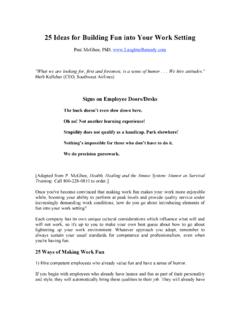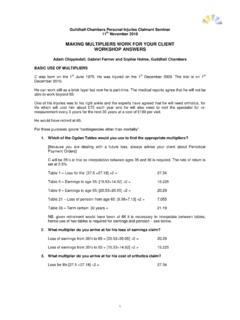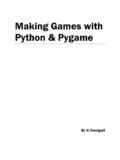Transcription of Making Laminated Rolling Pins - HillCountryTurners
1 Making Laminated Rolling Pins Introduction Why go to the trouble to make a Rolling pin when you can go down to your local discount store and buy one that works just fine for less than $5? As wood turners, there is always the joy and fun of Making . Aside from our own selfish pleasures, there are some other practical reasons. Relative easy of Making Very functional Attractive Make great gifts Sell well at craft shows As mentioned above, the Rolling pins themselves are easy to make and require the simplest spindle turning techniques. The most time consuming part of the process is preparing the turning blanks. Therefore, I will spend a considerable amount of time describing the materials used, blank preparation, and the Rolling pin dimensions I have found to work best. I will also briefly describe my finishing technique and recommended aftermarket care. I will describe the Making of three different types of Rolling pins.
2 The first is what I call the Osolnik style, so named because I believe Rude Osolnik first made this particular style of Rolling pin. The second is the common pastry or French Rolling pin. Finally, I will describe my version of the traditional Rolling pin. Materials Over the years, I have found that if you are preparing a bunch of blanks it is easier and more efficient to just buy kiln-dried dimensional lumber. By all means, use all of your leftovers and scraps, but the task will be easier and quicker if you re starting with nice, clean dimensional 4/4 lumber. I always use three contrasting woods for my Rolling pin blanks, typically Walnut, Hard Maple, and Cherry. If you are buying lumber, select boards to minimize waste. For example, choose widths that are multiples of your blank width + your saw blade kerf. Also, choose board lengths that are multiples of your blank lengths.
3 I will discuss the Rolling pin blank dimensions later. A good local source for dimensioned hardwood lumber in our geographic area is, Dakota Premium Hardwoods 4441 Center Gate San Antonio, TX 78217 210-967-1316 They will allow you to buy lumber in small quantities and you can select your boards. The last time I purchased lumber from them, Hard Maple was $ , Cherry was $ , and Walnut was $ At these prices, each Rolling pin blank will cost about $8. A similar blank from Craft Supplies is about $35. 2 Blank Preparation As mentioned earlier, blank preparation is the most time consuming part of the process. Normally, I like to prepare 20-25 blanks at a time. Cutting Dimensions Join and surface each board edge and face as needed to achieve accurate and safe cuts. Use contrasting woods for best effect. I ve found that alternating Walnut, Maple and Cherry gives a pleasing combination.
4 See Figure I below. Cross cut each board into 24 lengths Rip each board section into 2-1/4 widths Figure 1 Complimentary Woods for Making Rolling Pin Blanks Glue-up steps Starting with a pile of each type of cut boards, dry stack them on edge, face-to-face, alternating the 3 types of wood. See Figure 2 below. After you are satisfied with the arrangement, spread a heavy coat of glue on one side of each board. I use a small 3 paint roller to spread the glue. Important-only glue-up the amount of material you can handle safely because you are going to bandsaw the individual blanks later. Work quickly during this step so the freshly spread glue doesn t get too dry. I generally glue up about 15 boards at a time. This is a messy operation. I generally tape down a piece of plastic on the work surface to contain the mess and make clean-up easier.
5 The type of glue used is optional. I generally use Titebond II . After the glue is spread and all the boards aligned, clamp the bundle of boards and let them dry overnight. Try to clean up as much as the glue squeeze-out as possible before drying. This will make it easier to cut out the individual blanks from the bundle Figure 2 Stacked Boards Prior to Glue-Up 3 Marking Out and Bandsawing the Blanks You now have a large mass of glued-up wood that s sufficient to cut several Rolling pin blanks. By trial-and-error I have found that the best visual effect is obtained when the blank is sawn so the edge is 5-6 degrees from the original glued-up edge. Refer to Figure 3 below Figure 3 Mark-out the Glued-Up Blanks It turns out you can get this approximate angle when you draw a line from the bottom outside corner of the 1st board to the top outside corner of the 3rd board.
6 Simply repeat this process to mark out additional remaining blanks. You will get the magic 5-6 degree angle as long as you have boards that are thick and 24 long. By marking out all blank in this manner, you will have blanks that are 2-1/4 square. After marking out all of the Rolling pin blanks on the large glue-up, cut out the individual blanks on the bandsaw. Depending on the size of the glue-up, you may want assistance with this operation. Next, square off the ends of the blanks so they can be easily mounted between lathe centers. See Figure 4 below for a finished blank. Figure 4 The Finished Rolling Pin Blank You are now ready for the easy part---- Making a Rolling pin. Making a Rolling Pin Over the years, I have made dozens of Rolling pins of various sizes and designs. I have given away many to friends and family and have sold many at craft shows.
7 They have always been a popular item and reliable seller. As mentioned earlier, turning a Rolling pin isn t high tech spindle work. The job can be done with three basic turning tools. First you need a spindle roughing gouge or a sturdy bowl gouge to convert the blank from square to round. Next, you need a parting tool to mark off critical 4 dimensions. Finally, you need a spindle or detail gouge to turn the handles. Those proficient with a skew can add a 4th tool to the arsenal. Sandpaper is NOT considered a tool! I ve played around with different designs, but have settled on three basic types. I ve provided a photograph of each type along with typical dimensions. I ve also noted a few variations you may want to consider. Also, I will point out areas where special attention should be given in order to get a better product. Osolnik Style Rolling Pin I first saw this style of Rolling pin in Rude Osolnik s craft shop in Berea, KY in the late 70 s or early 80 s.
8 While Rude was best known for his candle sticks, he also made many Rolling pins with the characteristic round ball on the ends. Although I ve never kept any data, this is probably my best selling Rolling pin. An example is shown in Figure 5 below. Figure 5 Osolnik Style Rolling Pin I generally make this Rolling pin about 17-1/2 total length with a barrel length of 11 . The barrel diameter is about 2-1/8 . IMPORTANT----Make sure the diameter of the balls is slightly smaller than the diameter of the barrel. Otherwise, on a flat surface the Rolling pin would rest on the handles rather than the barrel. For best appearance, Make the ball handles as spherical as possible Make the transition between the barrel and ball smooth half coves and try to make them look the same on both ends. Pastry/French/Pasta Rolling Pins In recent years these style of Rolling pins have become very popular.
9 There are many variations, but I have settled on two styles, one with tapered ends and one with a straight cylinder. Figure 6 Tapered Pastry Style Rolling Pin I generally make the tapered end rollers about 20-1/2 overall length and 1-7/8 diameter barrel. About 4-1/2 from each end, I begin tapering the barrel to 1-1/8 at the ends. An example of the tapered pastry Rolling pin is shown above in Figure 6. These dimensions can be changed to fit individual taste. 5 For best appearance, Round over the ends with a smooth curve. Smooth the transition point where the taper begins so there are no noticeable interruptions in the overall profile. Another variation is to make the Rolling pin a simple straight cylinder as shown in Figure 7 below. Figure 7 Straight Pastry Type Rolling Pin I generally make these 20 long and 2 diameter.
10 If you prefer a more slender appearance, reduce the diameter to 1-3/4 . Chamfer the ends for a better appearance and feel. Traditional Style Rolling Pin I call these traditional styles because that s the kind of Rolling pin my Mother and Grandmother used. Perhaps that only makes them traditional to me. The only real decision in Making this style is how to make and attach the handles. There are basically 3 different options. Make the handle an integral part of the Rolling pin body. Make the handle separate with a tenon on the end. The handle is then glued into a hole drilled in the end of the Rolling pin body. Take the fancy approach. Make a hollow handle such that a dowel rod can be inserted. Glue the dowel into the Rolling pin body. Make an end cap to fit the end of the dowel to hold the handle in place. This is a bearing type handle which allows the handles to remain stationary while the body of the Rolling pin moves.







